I am still on my way from, well, Heidelberg for all intents and purposes, to Malta. Yesterday's account ended when I had boarded the night train to Siracusa at the Roma Termini station at about eleven in the night. Although the pillow supplied by FS was somewhat on the hard and flat side, I was quickly asleep and slept until…
Calabria (7:40)
Almost the best part about a journey on a night train is when you awake. You open the window, peek out and wonder where the machine has taken the little shell that is your cabin. Today, that first view was particularly gratifying in that I was rewarded with an ocean view:
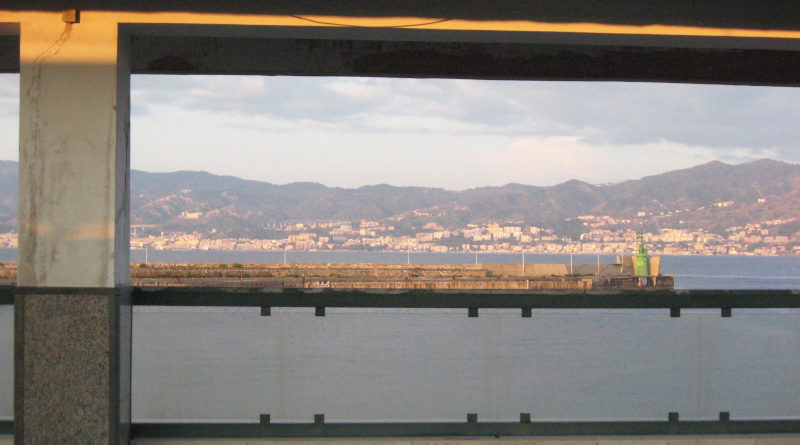
There is even a ferry in view, also run by the Italian state railway FS. It turned out that this is how our train would cross the strait of Messina:
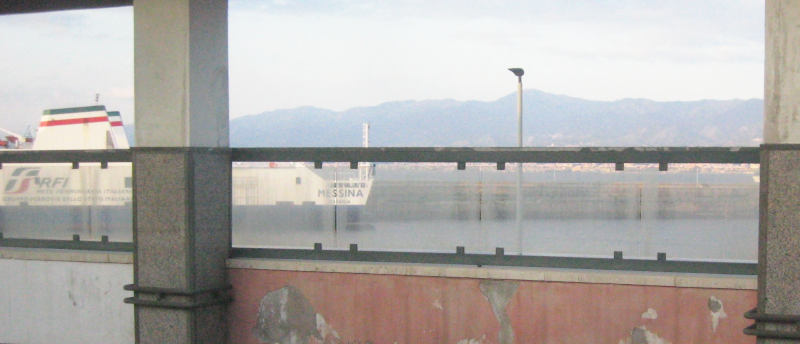
What woke me up was that the train has come to a stop, and it stops here, in Villa San Giovanni, for quite a while. So, I got to step out of the train for a moment. What can I say? It's warm, at seven in the morning it's totally T-shirt weather! What a welcome change from the cold, damp weather we have (mostly) had in Germany for the last few weeks.
My cabin window has a little tilting pane (is that what you call it?), and I have opened it as far as it will go. Mild, Mediterranean air is streaming in. Very good.
Now the train is shunting; Car by car is being pushed into the large ship's belly. Perhaps it is a bit silly that they don't just ask people to disembark and take another train on the other side. But then, no, this is exciting, and I am actually grateful that I don't have to leave my little shell just yet.
On the high seas (8:20)
Huh! In the belly of the large ferry I had not noticed the ship had left San Giovanni harbour.
Pro tip for this particular train: Do not order your breakfast for eight, because that's when the ferrying happens. You are allowed to step out of the train and enjoy the splendid panorama of the strait of Messina, and you wouldn't want to waste that moment on something as profane as having a breakfast.
What alerted me were the shimmering reflections of the sun on water that suddenly showed on the ship's wall just outside of my window. I grabbed my tea and my camera to brethe a bit of sea air. Yes, the sleeper cars are on the ship:
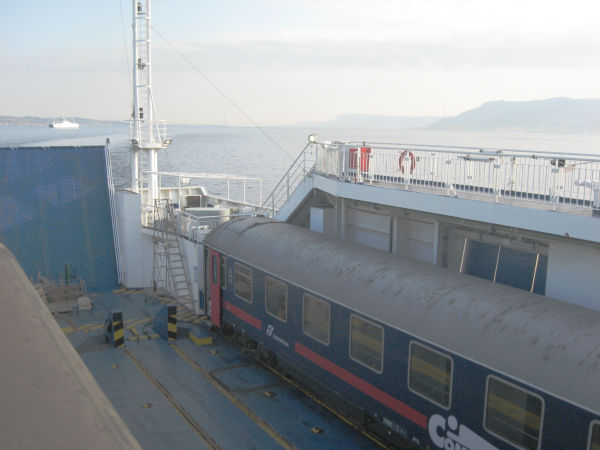
Say what you want, but in this moment I am fairly happy that the strait of Messina bridge does not exist yet. The Wikipedia reports that that bridge's opening is planned for 2032. I doubt that that is a realistic estimate, but still: if you would like to share the experience of being ferried in a rail car (and the generous shunting on each side), book one of the Roma-Siracusa or Roma-Palermo night trains soon. I, for one, liked this a lot. It is hard to beat the view of entering a harbour when it comes to feeling that one is travelling:
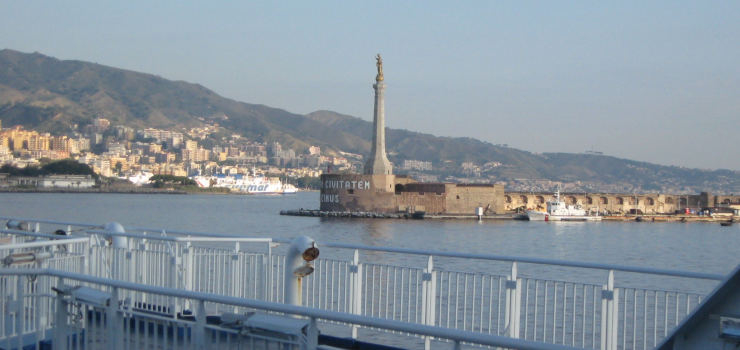
The sleeper train (10:30)
We have spent a long time in Messina, without an engine. This also means that there is no power, and that gets me to another pro tip: Better use the toilet before the shunting in Messina, because without an engine, there is no light in the toilet, and flushing probably will not work either.
A propos: What's this train like? So, the “Excelsior” it says on the outside is probably a bit of an overstatement, in particular compared to its US counterpart. For instance, there is no shower. My room has a sink for basic hygiene, though:
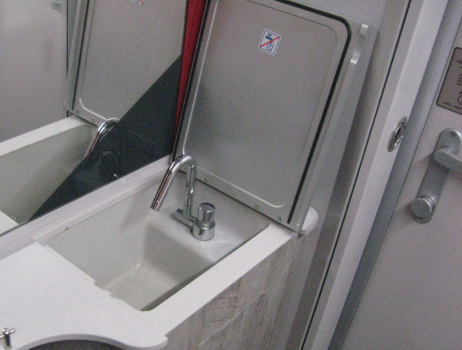
Given one does not spend three days in this train – as can happen for the US trains –, I am fine with that, but I will say that found the showers the ÖBB has on its night trains rather convenient when I went on to work right after my arrival.
The bed was fine for me; as usual for sleeper trains, it helps if you are not taller than 1.80 m:
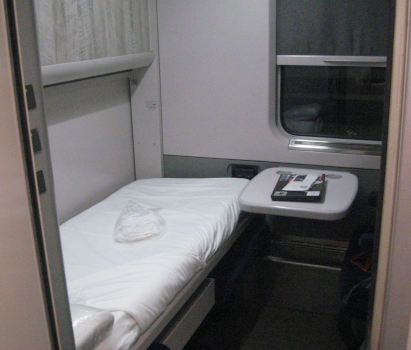
I believe this train went relatively fast by sleeper train standards, because I seem to remember the occasional tug during the night; the Transsiberian, for instance, runs a lot quieter. But then at least I like being gently rocked into sleep, and train did that well. As I said above, it was the absence of motion that woke me up at the strait of Messina.
In ÖBB night trains, they place a bottle of drinking water in the cabins, which is nice mainly because what comes out of the faucet in these trains is probably marginal at best even for brushing your teeth. I did not find a water bottle in my cabin in this train, but it turned out I was just too impatient: The conductor will bring one shortly after departure.
But you will probably want to bring some victuals aboard anyway; if there is some sort of food provision somewhere on the train, I have not found it.
And since I have ranted about wifi far too often in the travelogue already, let me just say: There is none on ICN 1959. But then: Better sleep or watch the landscape while you ride. My cabin's window, for that matter, looks into the interior of the island, which means that I get to see quite a bit of Sicilian landscape:
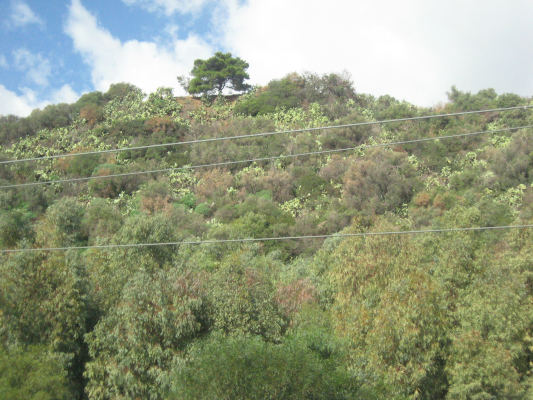
But to see the ocean, I have to step out into the aisle. Which I just did, in Taormina:
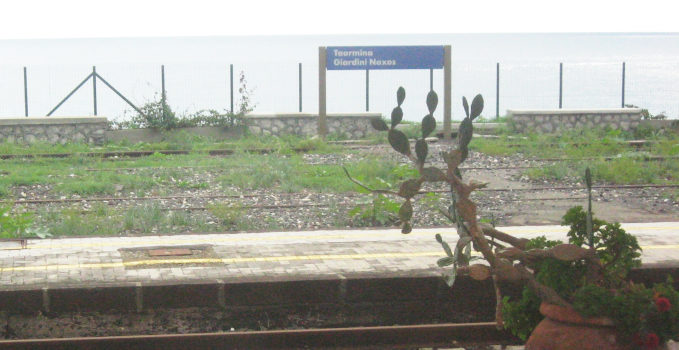
Rain (12:00)
In 30 minutes this train will have reached Siracusa. You know what? I don't want to arrive. It's cozy in here, in particular now that the rain patters against the window. Oh yes. Rain. In Sicily. I cannot say I am too surprised, because last time I was in Catania, it was rather wet, too.
But today, I will spend something like two hours in Siracusa and another four hours in Pozzallo, waiting for the Malta ferry to depart. I have to admit that I had intensive fantasies of spending that time blinking into a warm November sun. But now: Large puddles glitter on every path without serious inclination, and the ones with a serious inclination have turned into streams.
Here, between Catania and Siracusa, there are large areas of agriculture, fields, orange groves, other green things. Where there have been cactus and macchia near Messina (oh, the sun of Messina!), here, through curtains of rain, it is unthinkably that any cactus would thrive in this sea of green. My ideas of Sicily will never be the same again.
But ha! I see bright skies where the train is heading.
Bus to Pozallo (14:20)
My itinerary forsaw that in Siracusa I would enter the bus to Pozallo, the ferry port to Malta. I was seriously worried about this particular leg of the journey; busses give me the creeps because you never know where they will stop and where they will go from there. That there seemed to be no rail to a major port seemed hard to believe; but if the Gleisnost people cannot find anything, I trust there is nothing.
On the plus side, I had two hours to figure that out, which seemed ample. Also, the sun showed again, so I pulled a hat out of my backpack and started to explore Siracusa a bit.
For an indentured scientist like myself, Siracusa of course has the special appeal of being the place where Archimedes is said to have rebuffed a Roman soldier with “Don't disturb my circles” – and have done quite a bit of rather advanced research on top. How much of this actually happened I will not try to fathom, but modern Siracusa certainly cashes in on the Archimedes stories. There is a museum on Archimedes and Leonardo da Vinci, every third restaurant has some sort of Archimedean theming, there is a shopping mall bearing his name, and there are at least two monuments for him. One is a “homage to Archimedes” in the shape of a gracious greek letter π:
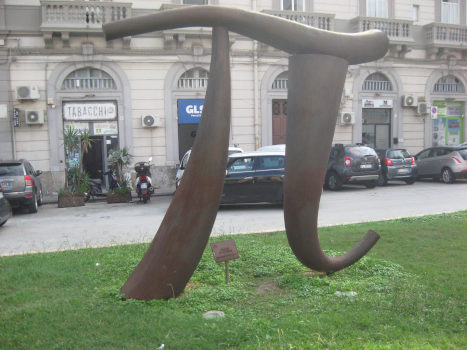
That has a surprising amount of sense, because Archimedes indeed gave an algorithm to compute π, although he almost certainly did not write or think π for the ratio of circumference and diameter of a circle.
And then there is a slightly larger-than-life statue of Archimedes near the head of the bridge between mainland Sicily and the island of Siracusa and hence close to the place where the fateful encounter between Archimedes and the Roman army might plausibly have taken place. This is also mathemantically interesting in that its base is made up of the pieces of the Ὀστομάχιον, the Stomachion, a geometrical puzzle Archimedes invented (well: is said to have invented) as tool to explore geometrical combinatorics.
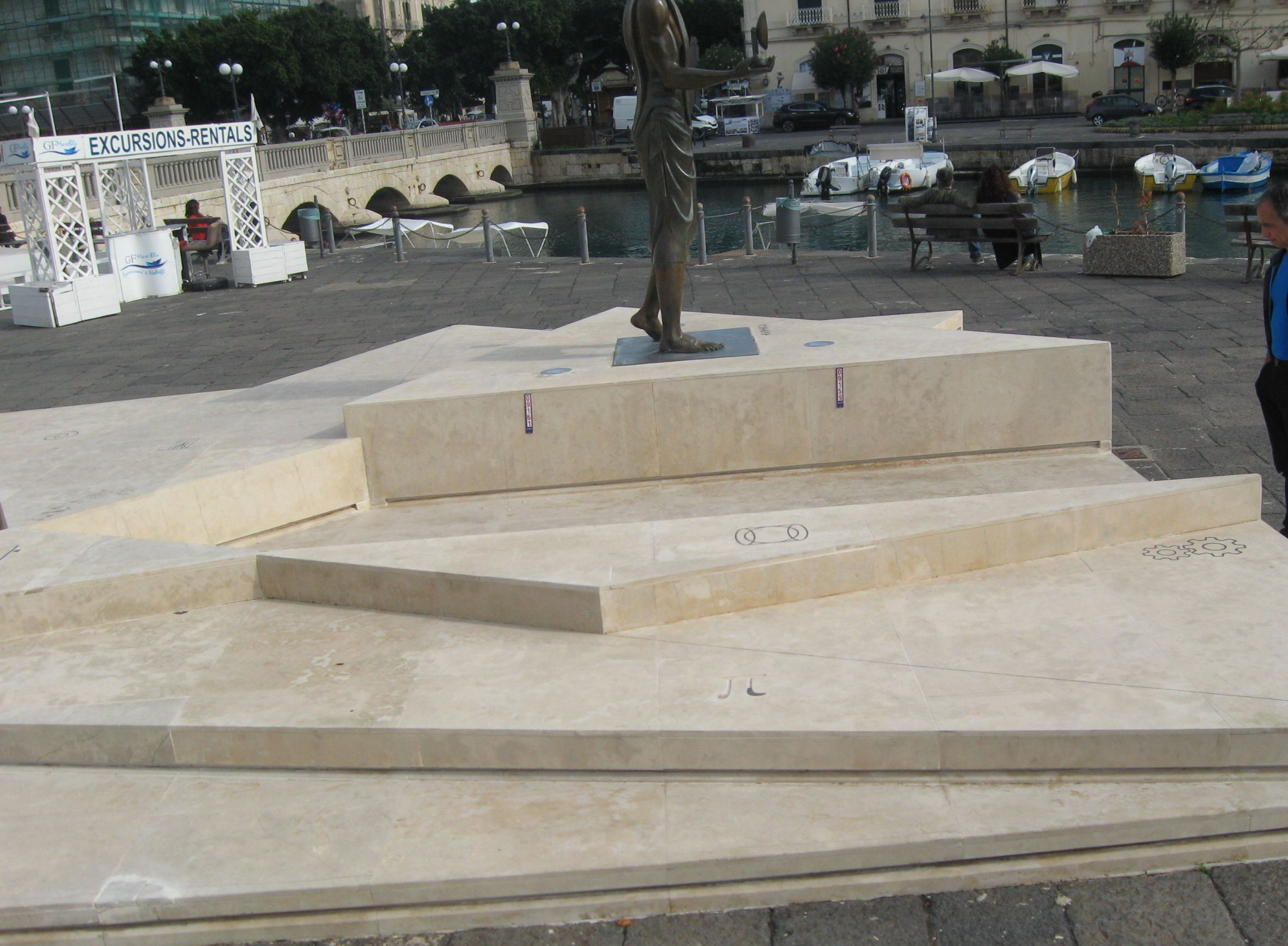
The slightly depressing part about Archimedes is that according to Plutarch, he would have developed weapons to defend the rulers of ancient Syracus against the rulers of ancient Rome. It is quite a bit beyond me how someone who was obviously fairly smart would do a silly thing like that. In case my bewilderment is not immediately obvious to you, I would like to refer you to my recent musings about defence (sorry, in German).
After that exploration I had to return to the more imediate challenge of figuring out where the bus to Pozzallo would depart. Thankfully, the station of Siracusa still has human staff, and they reassured me that the bus would depart “from here”. It was just that everything bus-related I saw on the station's piazza was a seriously inconspicuous sign without any markings as to which bus lines might actually serve that bus stop. Meanwhile, around the corner from the station is an actual bus terminal. That had lots of indications which busses would depart when and where. But my bus, the PA 112, was not among them.
As the departure time, 14:30, neared, I was somewhat reassured by several other travellers gathering around the bus stop sign on the piazza. But when the bus, a rather generic white affair not betraying at all that it is operating a line of the grand Ferrovia dello Stato –

– arrived and stopped opposite to the bus stop sign, they appeared rather confused as well. To be fair, the line number was taped into the front window. Clearly, some improvisation was applied here:
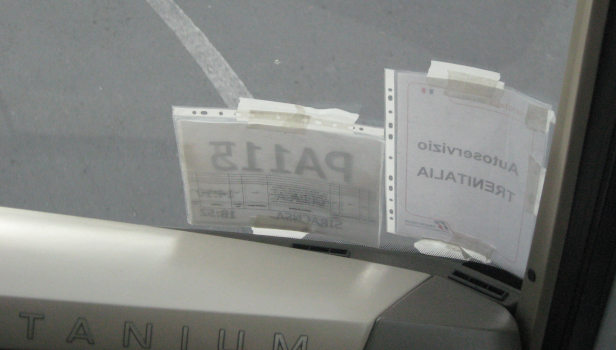
On the bus (15:30)
In case you, like me above, wonder how it is that a major ferry terminal (the only one with a connection to Malta, it would seem) is unreachable by rail: It turns out that there is rail infrastructure along the road. The bus called in a town called Avola to drop off people at that town's station, and even after Avola, we were still occansionally following a rail track. Could it be that FS indulges in the same folly that DB indulges in right now, where they completely shut down lines for renovation? In that case, I would just have been unlucky, and I could have reached Pozallo by train, say, a year ago? Am I riding what in Germany everyone fears as Schienenersatzverkehr[1]?
Then again, the bus ride through all the Sicilian towns to a driver-provided sound track of Italo pop certainly added some spice to the journey. Like the Ape parked roadside in Noto offering clearly locally-produced chestnuts and oranges off its truck bed. For the latter, a lot greener than what you would get in the supermarket, I would have liked toget off the bus. Noto proudly proclaims it is UNESCO world cultural heritage. Indeed.
A few minutes later, descending from Noto offered a nice ocean view:

Still, it is a bit of an insult to a train nerd if one sees a one-track rail line being closed entriely due to construction next to the huge structure of the motorway A18. No wonder everyone is in their car while the trains are… Uh, no, at least yesterday's trains were not empty at all. Hm.
At the ferry terminal (18:10)
It is now patently clear that going to Malta by rail is nothing anyone has planned for. How do I know this? Well, the bus from Siracusa dropped us off at a random-feeling filling station; now that I consider the situation in the Openstreetmap, I see a certain logic in that the Pozzallo train station is relatively close by.
But more to the point, from there to the ferry terminal it's a walk of about three kilometers, and there is no indication that any sort of public transportation is intended to cover that distance. All this might be a lot better once the trains run again; right now, it positively felt like an adventure. On the plus side, I got some beach time and a pretty sunset.

The Mediterranean felt warmer than the North Sea in summer, if that's what you wanted to know.
And then I felt rather lost again because pedestrian access to the ferry terminal is nothing anyone has perceptibly planned for. There is a sign, but that obviously addresses cars rather than humans:

If you follow that sign, you find yourself on an endless parking lot with no indications where to turn if you are on foot. There are just slightly unhinged motorcyclists:

Fortunately, some kind soul (from within an SUV no less) reassured me that this was the right place and I'd just have to wait until 18:30, which is when the ferry terminal opens.
Again fortunately, that was not quite right, because at about 17:40 a drizzle set in. There is no roof on the parking lot. But once I had navigated a maze of construction fences, the ferry terminal turned out to be open (by the way, do not give up when the front entrance is closed; there is a side entrance, too), and with its lights it seemed like a much more welcoming place that it probably is thanks to the contrast to the dark parking lot.
On the ferry (21:15)
Boarding the ferry was a bit of a disappointment: As a fringe benefit of avoiding air travel, I had hoped to escape the humiliating “security” checks. But regrettably, the ferry is declared a “maritime security zone”, which means that you have to pass a portal scanner and have your luggage x-rayed. Who knows what they were looking for? At least they didn't give me a hard time because of my swiss army knife, and they even let me keep my water. Gosh! Unthinkable that the ferry won't be hijacked between here and Malta.
The ferry itself is a pretty massive vessel named after, of all people, Karol Woityla. It is a catamaran:

It makes a (given its size) stunning 60 km/h while on sea. I frankly suspect this kind of speed seriously threatens any CO₂ savings (versus flying, not versus staying at home, of course) I might be effecting by this adventure. You can step out on the rear side of the cabin, and the noise of the engine is rather impressive.
Inside, you are looking at your normal glitzy tourist ferry, including the one-armed bandits that I've never seen anyone operate on such a ship:
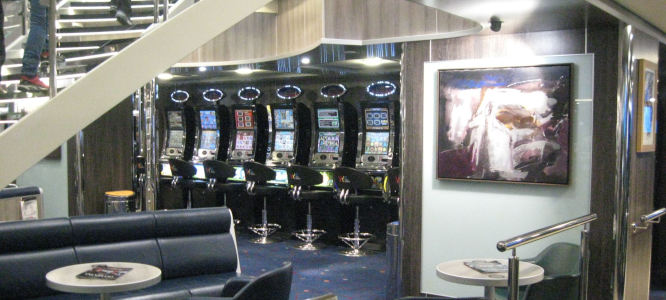
I managed to obtain a nice seat right behind the cabin's windscreens, sporting a table and even power to re-charge my computer. Regrettably, the cabin is brightly lit. Outside, a half moon hangs in the sky and mildly illuminates the sea. Without the bright light in here, the silver track half portside would certainly be breathtaking. The way it is, you can just make it out.
Idle chatter from my fellow passengers is around me, and I am looking forward to my bed; unless my map-fu deserts me, my hotel will be only be a few steps from where the ferry docks. After all the walking I have done today, that would be a welcome change. My only concern is: Will anyone still be there to let me in at eleven in the night? I am hoping for the island effect, where the arrival times of the ferries is an important driver for the inhabitants' rhythms.
| [1] | In case you are reading this because you are interested in rail travel and consider travelling on rail in Germany: “Schienenersatzverkehr” is when Deutsche Bahn replaces (that's “Ersatz”, which in French, I am told, to this day means “crap”) a train with busses. If you read that word of terror, simply despair and seriously think about hitch-hiking. Or going somewhere else. |
Zitiert in: Dossenheim to Malta on Rails
![[RSS]](./theme/image/rss.png)